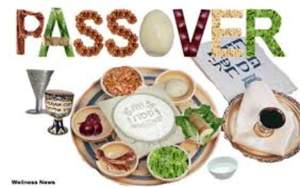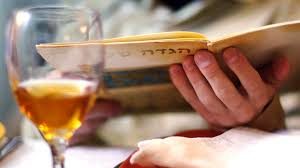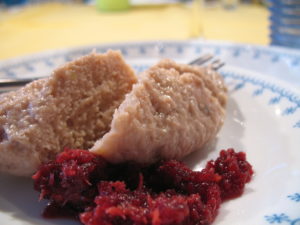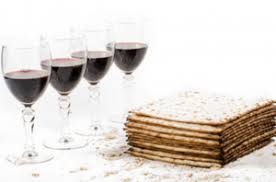Passover: A Spiritual Feast For Our Five Senses

The best way to learn about Judaism, and to absorb the plethora of knowledge into our psyche, is to engage all five senses—sight, sound, smell, taste, touch. And no holiday does this better than Passover, the most celebrated Jewish ritual at home. Obviously, the sages made provisions for our spiritual sustenance thousands of years before sensory learning became a thing. The Passover seder engages all our sensory needs, which makes this holiday a favorite among young and old and its lessons so timeless. Just as the sound of the shofar awakens our soul on Rosh Hashanah, the upbeat music of Dayanu livens the story of our journey from slavery to freedom. When we stimulate our senses, the lessons of our ancestors are engrained in our memories so that we pass our traditions down from one generation to the next, L’dor vador.
SIGHT
The dining table is visually appealing with candles, wine glasses, a beautiful embroidered matzo cover, fresh colorful tulips, china (or fancy paper plates), and maybe place cards with names of guests and a Haggadah at each seat. The optic nerve that sends information from the retina directly to our brain tells us the stage is set for something very special on the first and second nights of Passover. Just like Shabbat, we enhance the moment and make it truly memorable by making the table a feast for our eyes. At Passover when the kids were young, we acted out the 10 plagues, including pouring red food coloring into a pitcher of water to simulate the Nile turning into blood. By using props and visuals for frogs, lice, animals, darkness, locusts, and yes, even blood, Â the Passover story came alive.
Smell is one of our strongest senses, which is why a pregnant woman’s sense of smell and taste are so alerted when she carries and protects her baby. Our noses are incredibly sensitive—even just a few molecules can trigger a sensation of pleasure (matzo balls simmering on the stove) or unpleasant (a dollop of horshradish so strong our eyes water).
Certain smells have the power to trigger memories and emotions like no other sense. I always think of my mom of blessed memory when I get a whiff of her perfume Nina Ricci L’Air du Temps, and the coconuty smell of original formula Coppertone suntan lotion brings me back to swimming at the JCC and Florida beach vacations as a kid. Â Just as the sniff of cinnamon and cloves at Havdalah stay with us when we begin a new week, Â the aroma of matzo brei frying in the pan brings back memories of the breakfasts my mom used to make me every Passover. For me, the smell, taste, and sound of fried matzo sizzling in oil, the ultimate comfort food, is engrained in my brain and something I enjoy making every year for my own family.
TOUCH
While all other senses are located in specific parts of our body, only our sense of touch is distributed throughout our entire bodies. Our skin has more than four million sensory receptors, making touch one of our most pervasive and important senses. As a volunteer baby cuddler in the NICU of a local hospital, I can testify to the power of human touch and loving kindness. When I hold and snuggle  these newborns, they are not only comforted but science shows that human touch has profound impact on their growth, development, brain function, and more.  It feels good to give and receive a hug, a loving gesture.
When we greet family and friends at a holiday meal, whether in the intimacy of someone’s home or among hundreds of fellow congregants in our temple, we exchange hugs and kisses to show that person he or she is important to us. So take time to warmly greet each other and show you care.
HEARING
“Hear, Oh Israel, the Lord Our G‑d, the Lord Is One.†Judaism’s most iconic prayer, the Shema, begins with the command to “Hear!â€
We hear using our body’s very smallest bones, ossicles, which reverberate whenever our eardrum receives sounds, conveying soundwaves deep into our inner ears, where they are converted into electrical impulses that signal our brain. We even hear when we sleep, keeping our brains awake and alert with a constant stream of data from the sounds around us.
Judaism has long recognized the power of sound in creating intense feelings and memories. Whenever I hear the beautiful melody of Avot V’imahot in temple at Shabbat services, my mind goes back to when Jack and Sari became a bar and bat mitzvah and chanted this blessing on the bimah so beautifully. When the names of our patriarchs – Abraham, Isaac and Jacob – and matriarchs – Sarah, Rebecca, Rachel and Leah are recited, I’m flooded with emotion and have to choke back the tears so I don’t embarrass myself.
At Passover, when we sing Ma Nishtana (The Four Questions), our ears signal why this night is different from all other nights. And when we belt out  the song Dayenu (“it would have been enoughâ€), and  recognize God’s numerous gifts to us in the course of the Exodus, we can’t help but joyously pound our fists on the table hoping not to spill Concord grape juice on the tablecloth.
TASTE
Everything about being Jewish is a party for our taste buds. Even on Yom Kippur when we refrain from eating for 25 hours, we salivate thinking about the delectable blintze souffle at the break-the-fast meal the next day. Our tongues contain about 10,000 taste buds, each with between 50 and 100 receptor cells that detect sweet, salty, sour and bitter impulses to our brains.
Like smell, taste is closely connected to the amygdala, the part of our brain engaged in emotional learning. Tastes trigger memories and emotions, such as when we savor decadent strudel at a simcha. For me, strudel is the ultimate culinary esctacy, especially when it was lovingly made by Grandma Ruth, of blessed memory, or my mom’s best friend Estelle, who both labored in the kitchen to make strudel for my wedding and the kid’s coming-of-age ceremonies.
At Passover, we taste some of our favorite foods, from matzo ball soup and brisket, to farfel kugle and charoset and let’s not forget chocolate dipped cococut macaroons. Even my mom’s dried out Passover brownies sliced in perfect rectangles evoke memories that make my heart happy. And no one can resist the sugar-coated fruit flavored jelly slices that are strongly associated with Passover, even if I’d rather eat chocolate or an extra serving of Aunt Ilen’s baked kefilte fish.
On the first night of Passover this year, which falls on a Friday night, we say the Shehecheyanu before we drink wine. When we taste the fruit of the vine on our lips we feel united with everyone at the table and Jews around the world. When we dip the parsley in salt water and eat it, the karpas awakens our taste buds to anticipate the delicious bountiful meal to come. And when we taste the maror, the bitter herb, we are reminded of the suffering of our ancestors. Our taste tells a story, and when combined with our other senses of sight, sound, hearing, and touch, it’s no wonder Passover nourishes our soul.
Chag Passover Sameach!






